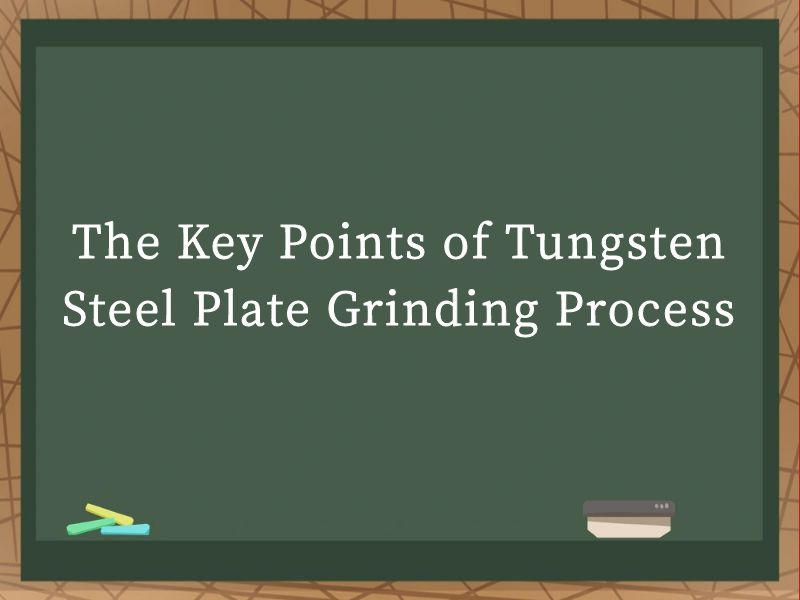JOURNALISM
- NEWS -
|
The Key Points of Tungsten Steel Plate Grinding ProcessThe Key Points of Tungsten Steel Plate Grinding Process.Tungsten steel, also known for its high hardness, wear resistance, and corrosion resistance, is widely used in various industries such as aerospace, automotive manufacturing, and precision machinery. Tungsten steel plates, as a critical component, often require precise grinding to meet specific dimensional and surface roughness requirements. This article delves into the key points of the tungsten steel plate grinding process, aiming to provide a comprehensive understanding and practical guidance for practitioners in the field.
1. Material Characteristics and Preparation Before delving into the grinding process, it is essential to understand the unique characteristics of tungsten steel. Tungsten steel is a type of alloy steel containing a high percentage of tungsten, which significantly enhances its hardness and wear resistance. However, this hardness also makes it challenging to machine, especially during the grinding process. 1.1 Material Selection and Inspection The first step in the grinding process is to select high-quality tungsten steel plates. These plates should be inspected for any defects such as cracks, porosity, or inclusions that could affect the grinding quality. Non-destructive testing methods like ultrasonic inspection or magnetic particle inspection can be employed to detect such defects. 1.2 Pre-Grinding Preparation Once the material is selected and inspected, it must be properly prepared for grinding. This includes cleaning the surface to remove any contaminants like oil, grease, or rust. Additionally, the plate should be clamped securely to prevent movement during the grinding operation, ensuring accuracy and safety. 2. Grinding Wheel Selection and Configuration The choice of grinding wheel is crucial in the tungsten steel plate grinding process. Different types of grinding wheels have varying characteristics that affect the grinding efficiency, surface finish, and tool life. 2.1 Wheel Type and Bond For tungsten steel, vitrified bonds and resin bonds are commonly used. Vitrified bonds offer high strength and heat resistance, making them suitable for heavy-duty grinding. Resin bonds, on the other hand, provide better flexibility and are often used for finer grinding operations. The abrasive grains used in these wheels can range from alumina to silicon carbide, with cubic boron nitride (CBN) being a premium choice for its exceptional hardness and wear resistance. 2.2 Wheel Specification The specification of the grinding wheel, including its grit size, hardness, and structure, must be carefully selected based on the material characteristics and desired grinding results. A finer grit size will produce a smoother surface finish but may require more time and effort. The hardness of the wheel should balance between the ability to hold the abrasive grains and the need for self-sharpening during grinding. 3. Grinding Machine Setup and Operation The grinding machine plays a pivotal role in the process, and its setup and operation can significantly impact the grinding quality and efficiency. 3.1 Machine Selection Choosing the right grinding machine is essential. Surface grinding machines, cylindrical grinding machines, or centerless grinding machines may be used depending on the shape and size of the tungsten steel plates. Precision machines with rigid construction and accurate control systems are preferred to ensure consistent grinding results. 3.2 Fixture and Clamping The fixture and clamping system must securely hold the tungsten steel plate without causing deformation or damage. Magnetic chucks, vacuum chucks, or mechanical clamping systems can be used, depending on the plate's size, shape, and thickness. 3.3 Grinding Parameters The grinding parameters, including wheel speed, table feed rate, and depth of cut, must be carefully adjusted to optimize the grinding process. Higher wheel speeds generally result in better surface finish but may increase the risk of thermal damage. The feed rate and depth of cut should be balanced to achieve the desired material removal rate without compromising the surface integrity. 4. Grinding Techniques and Strategies Effective grinding techniques and strategies can significantly enhance the quality and efficiency of the process. 4.1 Dressing and Truing Regular dressing and truing of the grinding wheel are essential to maintain its shape and sharpness. Dressing removes the dull or clogged abrasive grains, while truing corrects any deviations in the wheel's perimeter. Diamond or cubic boron nitride dressers are commonly used for this purpose. 4.2 Cross-Feed and In-Feed Grinding Cross-feed grinding involves moving the workpiece perpendicular to the grinding wheel's axis, while in-feed grinding involves feeding the workpiece into the grinding wheel. The choice between these two techniques depends on the specific requirements of the grinding operation. Cross-feed grinding is often used for finer finishing, while in-feed grinding is more suitable for rapid material removal. 4.3 Coolant Application The use of coolant is crucial in tungsten steel plate grinding to control the temperature and prevent thermal damage. Coolants can be in the form of emulsions, oils, or synthetic fluids. They not only dissipate heat but also help to flush away the grinding swarf and lubricate the grinding interface. 5. Post-Grinding Inspection and Quality Control After the grinding process, thorough inspection and quality control measures are necessary to ensure that the tungsten steel plates meet the specified requirements. 5.1 Dimensional Accuracy Dimensional accuracy is critical in many applications. Precision measuring tools such as micrometers, calipers, or coordinate measuring machines (CMMs) should be used to verify the dimensions of the grinded plates. 5.2 Surface Finish The surface finish of the tungsten steel plates can be evaluated using various techniques, including visual inspection, tactile profilometry, or optical interferometry. The surface roughness value (Ra) is a common metric used to quantify the finish quality. 5.3 Defect Detection Defects such as cracks, burns, or inclusions can significantly compromise the performance of the tungsten steel plates. Non-destructive testing methods like ultrasonic inspection, magnetic particle inspection, or eddy current testing can be employed to detect these defects. 6. Process Optimization and Continuous Improvement The tungsten steel plate grinding process is not static but rather a continuous learning and improvement cycle. 6.1 Data Collection and Analysis Collecting data on grinding parameters, material removal rates, tool life, and quality metrics can provide valuable insights into the process. Analyzing this data can help identify bottlenecks, optimize process parameters, and reduce variability. 6.2 Experimentation and Innovation Experimenting with new grinding wheels, coolants, or machine settings can lead to significant improvements in the grinding process. Innovation in fixture design, clamping techniques, or grinding strategies can also enhance productivity and quality. 6.3 Training and Skill Development The skills and knowledge of the grinding operators are crucial. Regular training programs on grinding techniques, machine operation, and quality control can help maintain a high level of competence and adaptability. The tungsten steel plate grinding process is a complex and critical operation that requires a deep understanding of material characteristics, grinding wheel selection, machine setup, and grinding techniques. By carefully selecting and configuring the grinding wheel, optimizing the machine parameters, and employing effective grinding strategies, practitioners can achieve high-quality grinding results with consistent dimensional accuracy and surface finish. Continuous process optimization and skill development are essential to maintain and improve the grinding process, ensuring that tungsten steel plates meet the rigorous demands of modern manufacturing. |


